Patellofemoral Syndrome (Runner’s Knee)- Part 2 Rehabilitation/Prevention
Written by Lachlan Chisholm – Runner’s Tribe
In my previous article, I outlined what patellofemoral Syndrome (click to read) is and what you should do once you have it or think you are developing it. I will now go through what you need to do to avoid getting it or avoid it coming back, as, the best way to treat an injury is to avoid it in the first place! I’m going to go through a series of stretches and exercises that you can do to help treat and prevent Patellofemoral Syndrome, these same stretches and exercises are also good for preventing most knee injuries. There are many different exercises that you can use but the below are some that are simple to perform and that I find to be successful for most of my patients (including myself). In terms of prevention if you only do 3 exercises the 3 with the * should do the job.
A few tips before I get into the exercises and stretches,
- Stretching should not be painful, in fact, if you do it right it should be an enjoyable experience. When stretching you only take your stretch until you feel a gentle stretch, you don’t pull or push as hard as you can! You only need to hold a stretch for 20-30sec – longer isn’t necessarily better.
- When doing any strength work technique is always more important than weight or number or repetitions! If you can’t do it properly stop as you will just be learning bad habits and risking injury.
Now for the exercises, this first one is just for those with patellofemoral pain;
Self patellofemoral joint mobilisation– this improves the range of movement of the patella to allow improved movement (this should only be used in those with “stiff” patella’s those rare people with PFJ from patella laxity should avoid this and should focus on strength exercises)
Sit toward the edge of a chair with your back straight.
- Bend one knee back in under the chair.
Stretch your other leg out in front of you with your knee almost straight, and muscles relaxed. - Place the heel of your hand on the outer border of your knee cap and glide it toward the inner side of your leg.
Foam Roller
- Roll down the outside of your thigh/quadriceps for 1-2 min each side.
- Hipflexor stretch *
Kneeling with one leg forward and the back knee on the ground just behind your hips
- Hips aligned side by side
- Do NOT “lunge” forward.
- Tilt pelvis up towards the roof (imagine the top of your pelvis is a bucket of water and you are trying to tip the water out the back of the bucket)
- Gluteal stretches
Lay on your back with knees bent and cross one leg over the other knee so your ankle is resting on your other leg.
- Reach through the hole your legs make with one hand and the outside of the leg with the other and hold the back of your leg.
- Gently pull your legs towards your chest until you fell a gentle stretch in your bottom.
VMO strength TB extension stage 1 * (there is a progression to this however I find many people get this one wrong even after a lot of hands on instruction, if done incorrectly you can do yourself harm so I won’t include it here as I have stuck to effective but easy to perform exercises. If you want the harder progression it would be best to get your physiotherapist or exercises physiologist to show you how to do the theraband split squat which is stage 2)
- Stage 1 – This is a good co-contraction of all the muscles that help to stabilise your knee.
- Stand with your feet shoulder width apart even weight on both legs
- Theraband behind one knee and let the band pull your knee forward
- Then push your knee back by flexing your quadriceps muscles and your bottom muscles and hold for 3-5seconds and then gently release. Repeat this 10 times on each leg.
- Crab walk/monster walk stage 1 and 2
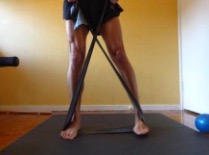
- Stand with your theraband under your feet and crossed over. Stand up tall shoulders back and bottom tucked under and legs straight.
- Then side step 10-15 times each way.
- If you are doing this correctly you should feel it in the side of your bottom (not front of your hips)
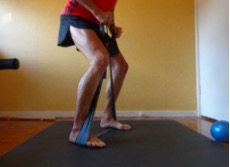
- Stand with your theraband under your feet and crossed over as for stage 1. This time bend your knees as if you are doing a ¼ squat (ensure you are sticking your bottom out and that your shoulders are above your knees and your knees are above your shoulders)
- Then hold this squat position and side step 10-15 steps each way.
- If you are doing this correctly your will feel it on the side of your bottom as above and on the inside of your thighs/quadriceps.
- Glut bridge
Lie on the floor with your knees bent. Squeeze your gluteals and then push your hips up until there is a straight line through knee and hip to upper body.
- Shoulders remain on the floor.
- Beware of rising too high or of flaring the ribs, which pushes the back into hyperextension.
- Hold this position for an increasing length of time up to a maximum of one minute.
- Perform two to three sets.
Other prevention tips to follow are your normal training protocols, for example, don’t increase volume or intensity too quickly, don’t change too much at once, for example don’t starting doing 3 sessions a week of plyometictics and introduce hill running at the same time. Start with 1-2 sessions of Plyo’s the 1st week introduce more over 3-4 weeks and then add in your hill work. The same goes for any new training, plan or periodise your training properly so you can gradually transition your phases of training or introduce new types of training as this will avoid overloading your body and allow natural adaptation which should lead to less injuries! But that is a topic for another time.
END
About Lachlan Chisholm
Lachlan was one of Australia’s leading 1500m runners for many years. His 1500m PB is 3:37 and he is a two-time Australian 1500m champion.
Lachlan currently works at Nowra Physiotherapy and Sports Injury Clinic
https://nowrasportsphysiotherapy.com.au/
Main cover photo: NSW State Champs 2017 – courtesy of Ewa Facioni
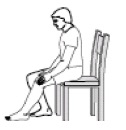 Sit toward the edge of a chair with your back straight.
Sit toward the edge of a chair with your back straight.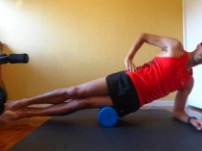 Foam Roller
Foam Roller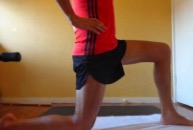 Kneeling with one leg forward and the back knee on the ground just behind your hips
Kneeling with one leg forward and the back knee on the ground just behind your hips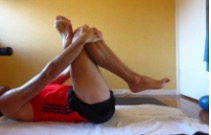 Lay on your back with knees bent and cross one leg over the other knee so your ankle is resting on your other leg.
Lay on your back with knees bent and cross one leg over the other knee so your ankle is resting on your other leg.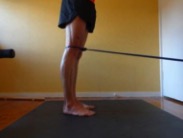 VMO strength TB extension stage 1
VMO strength TB extension stage 1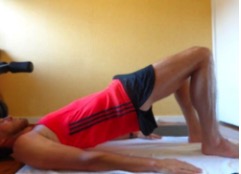 Lie on the floor with your knees bent. Squeeze your gluteals and then push your hips up until there is a straight line through knee and hip to upper body.
Lie on the floor with your knees bent. Squeeze your gluteals and then push your hips up until there is a straight line through knee and hip to upper body.